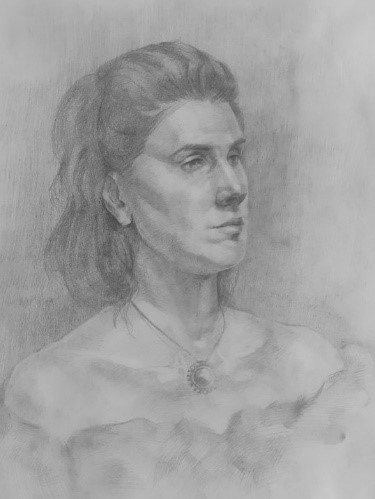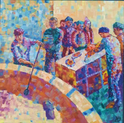
Painting
Course description
Painting is a form of fine art that uses paint to represent real-world objects and phenomena.
An artist painter is a creative person who is adept at using paints and pencils to convey their ideas, impressions, and experiences onto the canvas. They are skilled in the fine and performing arts.
Being an artist is a creative job that calls for a strong sense of inspiration, imagination, and drawing skill expertise.
Students who enrol in our program will master the fundamentals of Academic Drawing, Painting, and Composition as well as Graphic Design and Sculpture. Additionally, they will acquire both theoretical and practical knowledge and skills in the areas of contemporary art and art history. They will enrol in classes in paint methodology and art marketing.
Upon graduation, students will be qualified to produce and exhibit their own works of art, work and apply their expertise in the fields of culture, art, and design, and engage in educational activities.
Admission
The process for a professional (creative) exam for those applying for full-time study in the field of "Painting".
The exam is divided into three sections: "Drawing"- 100 points, "Painting"- 100 points, and "Composition"- 100 points.
The applicant chooses the theme for the composition by randomly selecting pre-chosen examination themes.
In "Drawing" the applicants use regular pencils of varying degrees of softness (H, HB, B, etc.). The applicant must accurately position a person's portrait on a tablet, appropriately construct a portrait of a person while taking into account the rules of proportion, and demonstrate a three-dimensional perspective while carefully manipulating light and shade. The activity on the theme of "Drawing" must be finished on a tablet measuring 40 x 55 cm.
In "Painting" the applicants use oil paint, watercolour, gouache, tempera, and acrylic techniques. The given person's portrait needs to be properly positioned on a canvas or 40x55 cm paper tablet. It is necessary to process a person's portrait while taking into account the guidelines for the right way to design a person in fine art and the right way to employ colour proportions in a colour scheme. The work must be finished, and it must be seen that the applicant is able to apply drawing techniques.
In "Composition" the applicant uses acrylic and oil paints, watercolours, gouache, and tempera. The composition is graded on the basis of the originality of the subject matter, the ideological content of the composition, as well as the appropriate use of colour in artistic and ideological expression. The images are expressed through plastic solutions, and special consideration is given to constructing proportions and a carefully chosen composition, in addition to the semantic and colour harmony of the theme, work skills, and level of performance.
The procedure for a professional (creative) exam for applicants for full-time education in the direction of "Painting". The exam takes place in three stages:
"Drawing " - 100 points;
“Painting” - 100 points;
"Composition" - 100 points.
The theme of the composition is determined by the applicant through the choice of tickets.
|
# |
Subjects |
Tasks |
Time |
|
1. |
Picture |
Portrait of a man |
3 hours (180 minutes) |
|
2. |
Painting |
Portrait of a man |
3 hours (180 minutes) |
|
3. |
Composition |
Create a composition based on a given task and theme |
3 hours (180 minutes) |
|
|
|
|
|
|





 Applicants in the subject "Drawing" work with ordinary pencils of different softness (H, HB, B, etc.). The applicant must correctly place a portrait of a person on a tablet, correctly build a portrait of a person, taking into account the laws of proportion, show a three-dimensional perspective, working with light and shadows in detail. It is required to complete the task on the topic “Drawing” on a tablet 40x55 cm.
Applicants in the subject "Drawing" work with ordinary pencils of different softness (H, HB, B, etc.). The applicant must correctly place a portrait of a person on a tablet, correctly build a portrait of a person, taking into account the laws of proportion, show a three-dimensional perspective, working with light and shadows in detail. It is required to complete the task on the topic “Drawing” on a tablet 40x55 cm.  An applicant in the subject "Painting" works in the technique of oil paint, watercolor, gouache, tempera, acrylic. The portrait of the presented person must be correctly placed on a 40x55 cm paper tablet or on canvas. It is required to process a portrait of a person, taking into account the existing rules for the correct construction of a portrait of a person in fine art and the correct use of color proportions in a color scheme. The work must be completed and, in the work, done, the ability to use the drawing technique must be felt.
An applicant in the subject "Painting" works in the technique of oil paint, watercolor, gouache, tempera, acrylic. The portrait of the presented person must be correctly placed on a 40x55 cm paper tablet or on canvas. It is required to process a portrait of a person, taking into account the existing rules for the correct construction of a portrait of a person in fine art and the correct use of color proportions in a color scheme. The work must be completed and, in the work, done, the ability to use the drawing technique must be felt. The entrant in the subject "Composition" works with oil paints, watercolor, gouache, tempera, acrylic. The composition is evaluated according to the originality of the topic presented, the compositional ideological content of the work, as well as the correct use of colors in artistic and ideological expression, the images are expressed through plastic solutions, attention is paid to building proportions and a properly selected composition, as well as the semantic and color harmony of the theme, work skills and degree of performance.
The entrant in the subject "Composition" works with oil paints, watercolor, gouache, tempera, acrylic. The composition is evaluated according to the originality of the topic presented, the compositional ideological content of the work, as well as the correct use of colors in artistic and ideological expression, the images are expressed through plastic solutions, attention is paid to building proportions and a properly selected composition, as well as the semantic and color harmony of the theme, work skills and degree of performance.